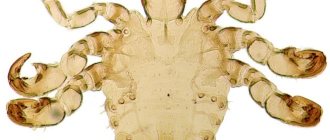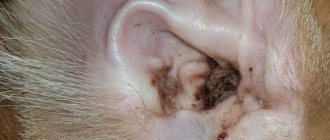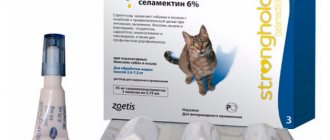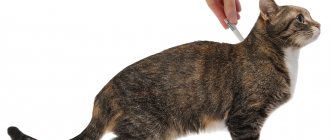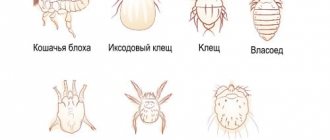Otodectosis (ear scabies) is a common parasitic infectious disease of dogs, ferrets, cats, and rabbits.
Otodectes cynotis, of the family Psoroptidae, is a parasite that lives in the external auditory canal and on the inner surface of the auricle. The scabies mite has a turtle-shaped shape. The abdomen, head and chest are fused together. There is a proboscis on the front of the body. There are four pairs of legs on the ventral side. The size of males is 0.2-0.6 mm, females - 0.3-0.75 mm. During reproduction, the female lays from several tens to hundreds of eggs during her life. The eggs are oval in shape, 0.18 - 0.2 mm long and 0.08 - 0.09 mm wide.
Development cycle
Otodectes cynotis is a permanent parasite, the entire life cycle of which is associated with the host organism; once it enters the external environment, it remains there for a short time.
The tick goes through 5 stages of development: egg, larva, protonymph, teleonymph and adult. The duration of transformation in males and females of the parasite is not the same. Under optimal environmental conditions, males actively develop within 14-16 days, and females within 18-20 days.
Outside their habitat (ear), ticks can live for a maximum of 24 days at an ambient temperature of 3-7°C and a humidity of 85-93%. On the body of animals (outside the ears), ticks remain viable for 22 days. Temperatures of -5 -(-20°) C are detrimental to ticks within 1-5 days. In boiling water, ticks die instantly.
The disease is not seasonal. Otodectosis most often occurs in cats, but this disease is rare in dogs. The disease is most widespread in places with a high concentration of animals when they are in poor hygienic conditions. Infection occurs through direct contact with animals affected by ear scabies, as well as through care items. Animals kept in apartments become ill when taken out into the wild, where they come into contact with other animals.
Otodectosis of cats - what is it?
Otodectic mange, ear mite, ear scabies are the names of the same parasitic disease caused by microscopic sarcoptic mites of the genus Otodectes.
A feature of the parasitism of the species Otodectes cynotis is a certain localization on the body of its owner, this is the inner surface of the auricle and the skin layers of the external auditory canal, that is, the outer ear. The parasite does not take root in other places on the animal’s skin.
Otodectes cynotis is an ear mite that parasitizes not only cats. The same type of otodectosis is found in dogs, fur-bearing animals, foxes and other carnivores, so a sick cat in the house can infect a dog and vice versa.
As the tick becomes parasitized, it needs blood and lymph for nutrition, which it obtains by gnawing and piercing the upper layers of the skin at the site of parasitism. These numerous lesions, richly flavored with waste products of mites, cause severe irritation of nearby nerve receptors, stimulating severe itching, which determines the main symptoms of ear mites in cats.
As the disease progresses, which becomes chronic, putrefactive microflora accumulates in pathological foci, which further aggravates the clinical picture of otodectosis. In particularly advanced cases, animals develop purulent otitis, perforation of the eardrum, penetration of pathological agents into the middle and inner ear, which often ends in the death of the animal.
However, it is worth emphasizing once again that this phenomenon is observed in rare cases when ear mites in cats are not subjected to any treatment.
Features of the disease
Among the total number of cats admitted to a veterinary clinic with a diagnosis of otitis, 85% of them are additionally diagnosed with otodectosis, which, in fact, served as the primary cause of inflammation of the outer or middle ear in the vast majority. If we talk about age, ear mites in cats are found mainly in kittens 1-4 months of age.
In the external environment, Otodectes cynotis is not able to survive for a long time.
- At temperatures below minus 5 degrees, the parasite dies within a few hours.
- A temperature of 0 to 5 degrees will ensure a maximum two-week survival rate for the tick,
- and the range from 10 to 20 degrees is about 3 weeks.
Such conditions ensure the transmission of the parasite from a sick animal to a healthy one indirectly through household items, hands and clothes of the owners. In the vast majority of cases, re-infection occurs directly through direct contact between animals. Unilateral damage can be observed in rare cases, only in the first stage of the disease. In the future, the pathological process always spreads to both ears.
Ear scabies occurs in cats everywhere throughout our country.
Brief biology of ear mites
Ear mites, parasitic in cats, are capable of reproducing exclusively in the area of the ears and ear canal of their owners. Like most sarcoptic mites, Otodectes cynotis sequentially goes through four phases of its development - egg, larva, nymph and adult, which is usually called the adult.
The season of the year determines the period of tick development from egg to adult. In the warm season, this time is up to two weeks, and in late autumn and winter - up to three weeks. Moreover, in cold weather, females lay a much larger number of eggs and closer to the eardrum - on the horizontal section of the auditory canal.
An interesting fact from the biology of ear mite development. The penultimate stage of the life cycle - the nymph has no signs of sexual demorphism. A female or a male may emerge from it in the future with equal probability. However, adult males, ready at this moment for fertilization, are already tightly attached to the nymph with the help of her special devices, which are called copulatory tubercles. In this state, the couple awaits the transformation of the nymph into an adult. If there is a female, the male fertilizes her and falls off, and if the individual is male, the seed is not cast, and the male detaches in search of a new nymph.
As noted above, the main symptom of otodectosis in cats is severe itching in the ear area, which is manifested by corresponding signs that any attentive animal owner can identify:
- The cat often shakes its head and ears.
- Rubs ears against any surface.
- Often tries to scratch his ears with his paws.
- Some animals may develop a characteristic symptom, which in veterinary medicine is called “bowheadedness.” The cat bows and holds its head in this state for a long time. Such a sign will indicate a severe course of the disease.
- Upon external examination, large accumulations of a brown or light gray viscous mass, strongly reminiscent of earwax, can be seen on the inner surface of the ears. Unlike sulfur, this mass has a very unpleasant odor and is often viscous in consistency rather than dry.
Ear mites in cats are a long-term chronic disease, with corresponding symptoms and requiring urgent treatment, since it will never go away on its own. Taking this fact into account, the clinical course of otodectosis is divided into three main stages:
Stage I
The first 14 days of the disease. The general condition of the animal, as a rule, does not attract attention, and only experienced and very attentive owners will notice that the cat is shaking its head very tensely and often, as if trying to shake something off its ears. If at this moment you look at the inside of the ear, you can see localized areas of severe redness. The first mites have already penetrated the skin, fertilization has occurred, and soon the first offspring will begin to hatch en masse. As a rule, living ticks are not detected under a microscope.
Stage II
From 14 to 21 days of illness. Sharp foci of redness on the skin of the inner surface of the ears lose the clarity of their boundaries, which become blurred (diffuse) and spread over most of the skin area. In places, a brown, foul-smelling mass may appear. At this moment, the animal begins to more actively scratch itself on the surface, loses its appetite, its coat loses its shine, and shedding may increase. In scrapings under a microscope you can find from 1 to 3 live mites.
Stage III
Occurs from 21 to 42 days of illness. The cat finds no peace, constantly trying to scratch and rub its head. The animal is very wary of touching its head and, at the first touch, begins to actively itch with its paw. Inflammation on the inner surface of the ears is always well defined and abundantly covered with a brown viscous mass with alternating dry crusts. This condition can last up to three months and lead to quite severe complications. Up to 10 living parasites can be seen in the microscope field.
Complications include the contamination of scratches and tick canals with streptococcal and staphylococcal microflora, which causes the development of a purulent-putrefactive infection with the subsequent spread of the pathological process to the middle and inner ear, then to the meninges.
Such complications of ear mites in cats are observed extremely rarely, as a rule, in sick animals exhausted by hunger and insufficient maintenance. Most often, otodectosis develops into a permanent chronic form, exhausting the animal, which loses more and more weight, and ultimately dies from general impotence.
How to clarify the diagnosis?
The diagnosis of ear mites in cats is one of the simplest and is based on the identification of symptoms and the results of laboratory tests. It is of no small importance to clarify epizootological information regarding otodectosis - the owner is always asked whether the animal has previously suffered from ear scabies, whether this disease has occurred in other animals in the household or neighbors.
Self-diagnosis at home is not particularly difficult, since the main difference between Otodectes cynotis is its parasitism in the area of the auricles and external auditory canal. Other scabies and fungal diseases with similar clinical signs, for example, notoedrosis, sarcoptic mange or trichophytosis, develop predominantly in other parts of the animal’s body.
If it is not possible to go to a veterinary clinic for an accurate diagnosis, you can try to conduct a preliminary diagnosis of ear mites in cats at home.
To do this, moisten a cotton swab in a 50% aqueous solution of glycerin or regular vegetable oil, then take a scraping from the inner surface of the ear, trying to catch as much of the viscous brown mass with crusts as possible with several rotational movements.
If possible, apply a few drops of a 10% caustic soda solution to the scraping in order to dissolve most of the ballast mass, then the material is kept at room temperature for about 45 minutes.
If it is not possible to purchase and use caustic alkali, you can immediately begin self-diagnosis. To increase the likelihood of detecting parasites, you can place 2-3 drops of black ink on the scraping, which will color everything except the mites themselves; they can be better seen against a black background due to the contrast. The presence of several light grains on a cotton swab may indicate the presence of parasites.
(The picture shows what an ear mite looks like in cats. The photo is not enlarged. Many of the white dots are adult parasites. For convenience, a cotton swab is painted with black ink and a transparent glass cylinder is used for focusing and additional illumination)
It is worth noting that such diagnostics at home are relevant only for the second and third stages of otodectosis in cats. Moreover, the absence of mites on the scraping does not exclude ear scabies in the presence of all other symptoms. Only professional collection and examination of scrapings in a veterinary clinic can guarantee the diagnosis of otodectosis or exclusion. For this reason, whether white specks were found or not, acaricidal treatment is still recommended.
Treatment for ear mites in cats
Treatment of ear mites in cats can be external, using liniments, ointments and drops, applying them directly to the lesion and in the form of subcutaneous injections of acaricidal drugs. The second option will be more effective, since the ticks absorb their toxin as they feed on blood and lymph.
In professional veterinary medicine, both approaches are often used simultaneously to treat otodectosis in cats of the second and third stages, which provides a much better effect.
Today, a remedy for ear mites in cats can be easily purchased at a veterinary pharmacy or pet store, but it is better to give preference to a pharmacy.
When working with cats, you need to remember that this type of animal has increased sensitivity to organophosphate acarids, so products containing diazinon, chlorpyrifos, fozalon, karbofos and similar compounds are not used in this species.
Such classic drugs in the treatment of ear mites in cats have an excellent and time-tested therapeutic effect, such as:
0.05% aversectin ointment. The entire inner surface of the auricle and the external auditory canal are generously treated with the product twice at intervals of a week.
Tanacetic or polysulfide liniments. Twice, interval – 7 days.
3% creolin, externally, according to a regimen similar to the drugs described above.
Stomazan, Butox, Ectomine, Bayticol. Externally, twice with an interval of 10 days.
Ivomec, Aversect-2 or Cydectin, subcutaneously, twice with an interval of two weeks. Dosage based on 0.1 ml of the prepared solution for every 5 kg of patient’s live weight.
In addition, you can use a self-made ointment if you can stock up on ingredients. Add 8 g of potassium carbonate and 15 g of colloidal sulfur to 20 g of unsalted rendered lard, mix thoroughly and apply externally every 2-3 days until symptoms disappear completely.
Materials used from https://vetserv.ru
Pathogenesis
Mites contribute to mechanical damage to the skin and cause irritation by waste products. In this case, redness of the skin first occurs, then swelling appears with the exudation of exudate. The exudate mixes with dead epidermis, secretions of the sebaceous glands, and waste products of the mite, and as a result, dark brown crusts form in the auricle. The affected areas of the skin are contaminated with microflora, which increases inflammation in the auricle. In extremely advanced cases of the disease, the integrity of the eardrum is disrupted and an inflammatory process develops in the middle and inner ear, and in the future the inflammatory process can spread to the meninges.
Symptoms of otodectosis
As the disease develops, animals affected by ticks experience severe itching, while they become restless, shake their heads, scratch their ears with their paws, damaging the auricle. The auditory canal and auricle are filled with dark brown crusts of dried exudate. When otodectosis is complicated by secondary microflora, an inflammatory process develops, which is often characterized by purulent discharge from the ears. In case of severe complications, when the eardrum is perforated, the animals tilt their heads towards the diseased ear, and when the inflammatory process spreads in the meninges, the animals experience lethargy, increased body temperature, and nervous phenomena.
Treatment of otodectosis
It is necessary to carry out daily mechanical cleaning of the ear canal from the secretions contained there throughout the entire course of treatment. To destroy the parasite, acaricidal preparations are used in the form of solutions, drops, ointments:
Amidel-gel, Amitrazine (Amitraz, which is part of these drugs, is an acaricide that is active against the larval and mature phases of parasite development). Amitrazine is instilled into the ears once a day, every three days, until symptoms disappear completely (6-8 times). Amidel gel must be placed in the ears once a day, 3-5 times with an interval of 5 days.
Oricin (Lindan, the active ingredient of the drug is an organochlorine acaricidal compound) is used to treat acute and chronic otitis media of bacterial, fungal and parasitic origin. Place in the ears 2 times a day until the signs of the disease disappear.
Acaromectin is an antiparasitic drug whose active ingredient is ivermectin. The drug is sprayed onto the inner surface of the ear and used twice with an interval of 8-10 days.
Frontline and Stronghold drops on the withers are also used to treat Otodectosis.
A bacterially complicated form of otodectosis is treated with antibiotics, after titrating the sensitivity of the microflora.
If Otodectosis is detected in animals that are kept in large concentrations, treatment must be carried out in all animals at the same time.
Treatment methods for ear mites in cats. How to get rid of ear mites in cats?
Treatment begins immediately after diagnosis: the ear is cleared of scabs and discharge, then special medications are administered, and soothing lotions are applied to relieve itching and irritation. The animal is comprehensively treated with special insecticidal preparations, and in case of secondary infection, antibiotics are added to the therapy.
Treatment of otodectosis in a cat lasts from a week to several months, it all depends on the severity of the disease. The earlier cat ear mites are detected, the easier it is to get rid of the parasites. If you contact your veterinarian when the first symptoms appear, you can quickly treat your pet at home using special drops. The drugs are prescribed by a veterinarian taking into account the individual characteristics of the cat.



